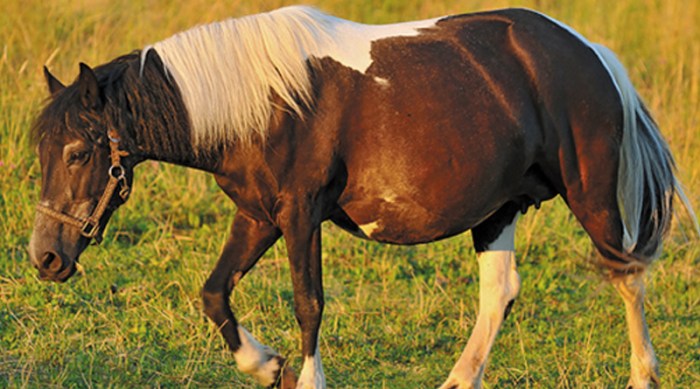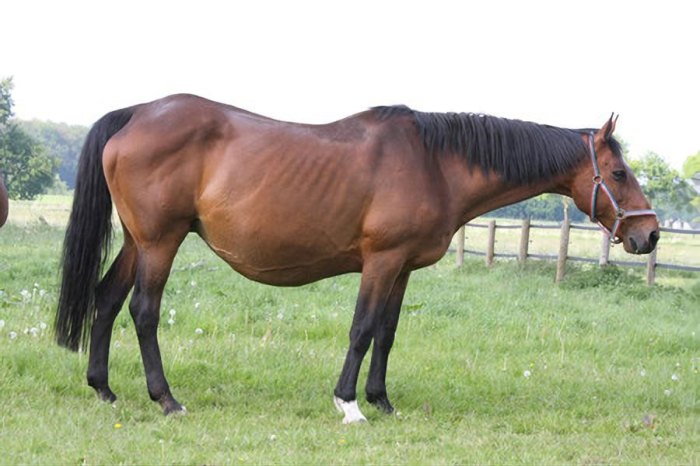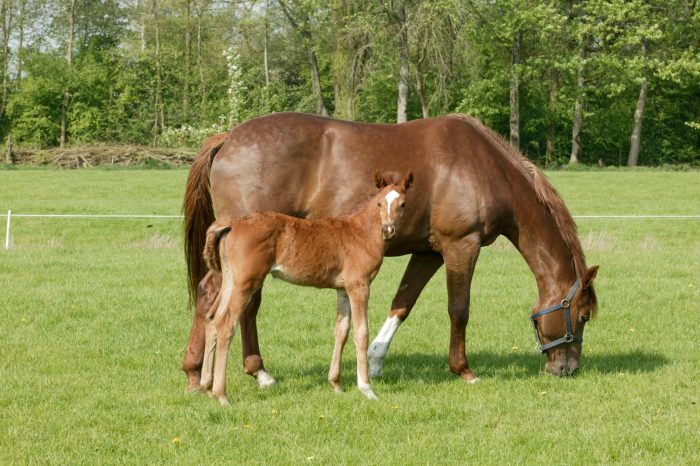As the topic of “cuanto dura una yegua preñada” takes center stage, this article delves into the intricacies of equine pregnancy, offering a comprehensive guide for horse owners and enthusiasts alike. Join us as we explore the gestation period of mares, from its duration to the factors that influence it, and delve into the signs of pregnancy, care during gestation, and the foaling process.
This guide is meticulously crafted to provide you with a wealth of knowledge, ensuring a reading experience that is both informative and engaging. So, saddle up and let’s embark on this equestrian adventure together!
Gestation Period of Mares

The gestation period of mares, also known as the pregnancy term, is the time from conception to the birth of a foal. It is crucial for breeders and horse owners to understand the typical duration and factors that can influence the length of pregnancy in mares to ensure proper care and management.
Typical Gestation Period
The average gestation period in mares is approximately 340 days or 11 months. However, there can be variations depending on the breed, age, and overall health of the mare.
Factors Influencing Gestation Duration
Several factors can influence the duration of pregnancy in mares, including:
- Breed:Different breeds of mares may have slightly different gestation periods. For example, Thoroughbreds typically have a shorter gestation period than draft breeds.
- Age:Younger mares tend to have shorter gestation periods than older mares.
- Health:Mares with certain health conditions or complications may have a longer or shorter gestation period.
Examples of Gestation Periods
Here are some examples of the gestation periods of different breeds of mares:
- Thoroughbred: 330-345 days
- Quarter Horse: 335-345 days
- Standardbred: 340-350 days
- Clydesdale: 345-360 days
Signs of Pregnancy in Mares: Cuanto Dura Una Yegua Preñada

Identifying pregnancy in mares is crucial for proper care and management. Various physical and behavioral changes can indicate pregnancy, and timely detection allows for appropriate veterinary attention and monitoring.
Physical Signs
Physical signs of pregnancy in mares typically manifest as changes in the reproductive organs and mammary glands. These include:
- Enlarged uterus:As the fetus develops, the uterus gradually expands, becoming palpable through rectal palpation.
- Cervical changes:The cervix softens and relaxes, allowing for the passage of fluids and the developing fetus.
- Mammary gland development:The mammary glands begin to enlarge and produce colostrum, a nutrient-rich fluid that nourishes the foal after birth.
Behavioral Signs, Cuanto dura una yegua preñada
Behavioral changes in pregnant mares can also be indicative of their condition. These may include:
- Increased appetite:Pregnant mares require additional nutrients to support the developing fetus, leading to an increased appetite.
- Decreased activity:As the pregnancy progresses, mares may become less active and spend more time resting.
- Nesting behavior:In the final weeks of pregnancy, mares may exhibit nesting behavior, such as pawing at the ground and seeking seclusion.
Rectal Palpation
Rectal palpation is a common method used by veterinarians to confirm pregnancy in mares. This involves gently inserting a lubricated hand into the mare’s rectum and palpating the reproductive organs. A skilled veterinarian can detect the presence of a fetus and estimate its age based on its size and development.
Monitoring
Monitoring a pregnant mare for signs of complications is essential for the well-being of both the mare and the foal. Regular veterinary checkups, including rectal palpations, can help identify any potential issues, such as uterine torsion or placental separation.
Care for Pregnant Mares

Pregnant mares require specialized care to ensure the health and well-being of both the mare and her unborn foal. This care encompasses proper nutrition, exercise, shelter, and regular veterinary checkups.
Nutrition
Pregnant mares have increased nutritional demands due to the growth and development of the foal. A well-balanced diet is crucial, providing adequate calories, protein, vitamins, and minerals. The mare’s diet should be adjusted gradually throughout pregnancy, increasing in calories and protein as the fetus grows.
High-quality hay, pasture, and grain supplements can meet these nutritional needs.
Exercise
Regular exercise is essential for pregnant mares. It promotes circulation, muscle tone, and overall well-being. Mares should be allowed to exercise daily, but the intensity and duration should be adjusted as the pregnancy progresses. Light to moderate exercise, such as walking, trotting, and light jumping, is recommended.
Shelter
Pregnant mares need a clean, dry, and well-ventilated shelter that protects them from the elements. The shelter should be spacious enough to allow for movement and have good drainage. Proper ventilation is crucial to prevent respiratory issues.
Veterinary Checkups
Regular veterinary checkups are vital throughout pregnancy. They allow the veterinarian to monitor the mare’s health, assess the foal’s development, and provide necessary vaccinations and deworming. Ultrasounds and blood tests can also be performed to monitor the foal’s progress and detect any potential complications.
The gestation period of a mare typically ranges from 320 to 370 days. Interestingly, the strength of a sheet of bcc iron 2mm thick can vary depending on its grain size and composition. Returning to the topic of equine gestation, factors such as the breed, age, and health of the mare can influence the length of her pregnancy.
Preparing for Foaling
As the mare approaches her due date, it is essential to prepare for foaling. The mare should be moved to a clean, well-bedded stall with plenty of space. A foaling kit should be prepared with supplies such as clean towels, iodine, umbilical tape, and a halter and lead rope for the foal.
During foaling, it is important to remain calm and observe the mare closely. If any complications arise, seek veterinary assistance immediately.
Foaling Process in Mares

The foaling process in mares typically lasts several hours and involves three distinct stages:
Stage 1: Preparation
The mare becomes restless and may paw the ground or lie down and get up repeatedly. Her udder fills with milk, and her vulva swells. The foal’s hooves and nose may become visible through the vulva.
Stage 2: Delivery
The mare strains to push the foal out, and the amniotic sac ruptures. The foal’s head and shoulders emerge first, followed by the rest of the body. The umbilical cord breaks as the foal is born.
Stage 3: Afterbirth
The mare expels the placenta (afterbirth) within 30 minutes to an hour after the foal is born. If the placenta is not expelled within this time frame, veterinary assistance is necessary.
Post-partum Care for Mares and Foals

After foaling, providing proper care to both the mare and her foal is crucial for their well-being and recovery. This includes monitoring their health, ensuring adequate nutrition, and creating a supportive environment.
Immediate Care for the Mare
Immediately after foaling, it is essential to check the mare’s overall condition. Assess her for any injuries, such as uterine tears or lacerations, and provide prompt veterinary attention if necessary. Ensure that the mare has passed the placenta completely, as retained placenta can lead to infections.
Monitoring for Complications
Both the mare and foal should be monitored closely for any signs of complications in the post-partum period. These may include fever, lethargy, discharge from the mare’s uterus or the foal’s navel, or difficulty nursing. Prompt veterinary intervention is essential if any of these signs are observed.
Nutrition and Support
Providing adequate nutrition and support to the mare and foal is vital for their recovery and well-being. The mare should be offered a high-quality diet with plenty of fresh water to support lactation. The foal should be encouraged to nurse frequently to receive essential colostrum, which provides antibodies and nutrients.
Essential Questionnaire
How long is the typical gestation period of a mare?
The typical gestation period of a mare ranges from 320 to 370 days, with an average of around 340 days.
What factors can influence the duration of pregnancy in mares?
Factors that can influence the duration of pregnancy in mares include breed, age, and health. For example, certain breeds, such as Thoroughbreds, tend to have shorter gestation periods than other breeds, such as draft horses.
How can I tell if my mare is pregnant?
There are several signs that may indicate that your mare is pregnant, including changes in her behavior, physical appearance, and hormonal levels. A rectal palpation performed by a veterinarian can confirm pregnancy.
